High Summer/High Peaks
20 July
Can I say immediately that I am really pissed off with the inconsistency of the weather this summer.
It doesn't feel as thought we have had more than two days at a time with the same weather pattern.
I've had a week off work and I've been trying to get the last of the garden chairs sanded and teak-oiled. Well, I've done bits and pieces here and there but I've hardly had much time to go at it. Still, there's three out of the four done now.
The garden is looking remarkably lush and, thanks to copious amounts of rain, I've not had to think about watering the flowers or filling the pond. In fact, we've had a very good display of colour throughout the growing season.



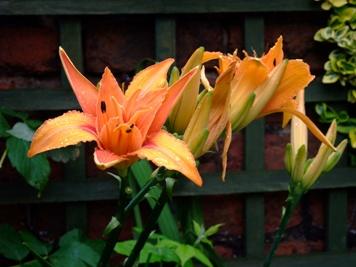
I got the expected letter refusing me the job at Liverpool Museum on Tuesday. I could pretend that I'm not disappointed but I won't. I'm really pissed by this turn of events. Somehow it had felt so right - and when that has happened to me in the past, usually things have gone my way. Anyhow, it's done. And so on with the next.
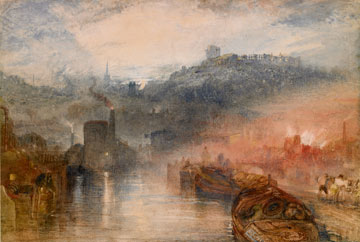 Ross and I took a trip out on Wednesday to the Lady Lever Art Gallery in Port Sunlight for an exhibition of Watercolours and Drawings from the collection of Lord Leverhulme - the gallery's benefactor. Well, it was alright. This Turner was probably the best thing on display - contrasting the light of the industrial heartland with the dark of the surrounding conurbation at night.
Ross and I took a trip out on Wednesday to the Lady Lever Art Gallery in Port Sunlight for an exhibition of Watercolours and Drawings from the collection of Lord Leverhulme - the gallery's benefactor. Well, it was alright. This Turner was probably the best thing on display - contrasting the light of the industrial heartland with the dark of the surrounding conurbation at night.
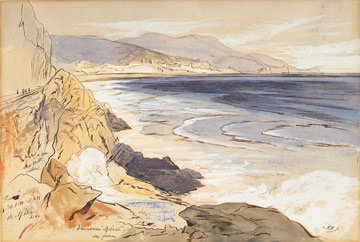 This work by Edward Lear, yes he of the nonsense rhymes, also caught our eye. Yes, it was a study but we liked the way that the verbal annotations now had become part of the work itself rather than working notes just for the artist. But, in all, it was a small show with not a lot in it to get excited about.
This work by Edward Lear, yes he of the nonsense rhymes, also caught our eye. Yes, it was a study but we liked the way that the verbal annotations now had become part of the work itself rather than working notes just for the artist. But, in all, it was a small show with not a lot in it to get excited about.
![]()
There was one definite highlight however and that was encountering the cloud covered Superlambanana outside the gallery. It demanded that photographs were taken. As you can see, I am modelling the latest in middle-aged paunches.
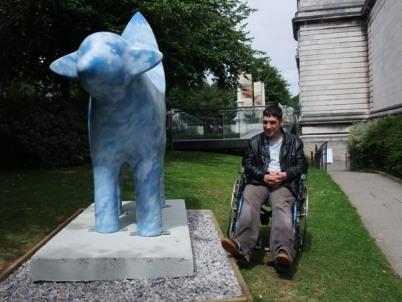

As well as my students at work getting in on the act, Sam's friend Lottie has been out on a Superlambanana hunt.
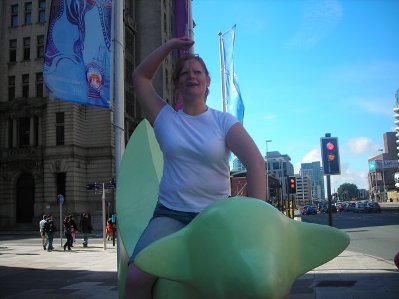
Apparently it's unsafe to mount them but I have the feeling that feisty young women should be encouraged to straddle the beasts whenever possible.
Lottie has, allegedly, gone on to perfect this technique with a member of the maritime profession.
Other offerings in the Superlambanana stakes include this wonderful tribute to Liverpool FC manager, Rafa Benitez.
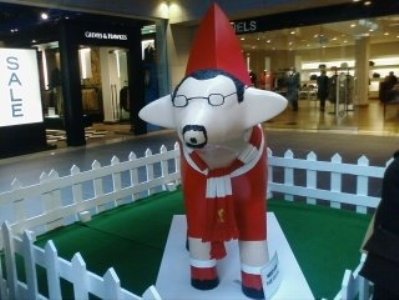
High summer has, for the past eight years, most often meant at least one trip to the High Peaks to Buxton for some out-of-the-way opera. The only year we have missed out was the year of the cruise. And there have been some very obscure works during that time.
- 2000: Franz Schubert's Fierrabras
- 2001: Giuseppe Verdi's Un giorno di regno
- 2001: Dimitri Shostakovich's The Nose
- 2002: Jacques Offenbach's La Périchole
- 2002: Francesco Cavalli's Erismena
- 2003: George Frideric Handel's Semele
- 2003: Gaetano Donizetti's Maria Padilla
- 2004: Gioachino Rossini's Il turco in Italia
- 2005: Otto Nicolai's The Merry Wives of Windsor
- 2005: Wolfgang Amadeus Mozart's Ascanio in Alba
- 2005: George Frideric Handel's Ariodante
- 2005: Giovanni Paisiello's The Barber of Seville
- 2007: Gaetano Donizetti's Roberto Devereux
And, of all of those, I would suppose that only the Semele is as near as you would get to a standard repertory piece.
It would be silly to pretend that they've all been raving successes but there are a number which I would not be unhappy to re-visit at some point - for example, Il turco in Italia, The Merry Wives of Windsor, Ariodante and Roberto Devereux would all make for another good night out.
 So, it will come as no surprises when I say that I don't suppose that I shall get many more opportunities in my lifetime to attend a performance of Albert Lortzing's Der Wildshütz. It's in the same vein as The Merry Wives of Windsor - good solid entertainment backed up by a perky lyricism. So long as you are not sitting there hoping for something revelatory (which some of the national critics appear to have done) then you will have a good time in the theatre.
So, it will come as no surprises when I say that I don't suppose that I shall get many more opportunities in my lifetime to attend a performance of Albert Lortzing's Der Wildshütz. It's in the same vein as The Merry Wives of Windsor - good solid entertainment backed up by a perky lyricism. So long as you are not sitting there hoping for something revelatory (which some of the national critics appear to have done) then you will have a good time in the theatre.
 James Rutherford was Falstaff in The Merry Wives and was good here as Baculus. However, though he sounds well, he still looks far too young for the rôles he is playing. I really liked Benjamin Hulett's clear lyric tenor as Baron Kronthal and Ashley Holland was fine as the randy Count Eberbach. Jonathan Best put in a stonking cameo as Pancratius.
James Rutherford was Falstaff in The Merry Wives and was good here as Baculus. However, though he sounds well, he still looks far too young for the rôles he is playing. I really liked Benjamin Hulett's clear lyric tenor as Baron Kronthal and Ashley Holland was fine as the randy Count Eberbach. Jonathan Best put in a stonking cameo as Pancratius.
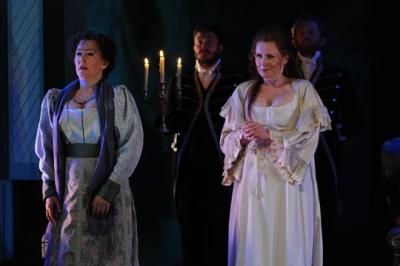 I was less happy with the ladies. Imelda Drumm had clearly modelled her Countess on Mad Meg. I don't think that she carried it off. Judith Howarth was much better in the twice cross-dressing rôle of Baroness Freimann. I wasn't as happy as some with Laura Parfitt in the soubrette rôle of Gretchen. To me her voice had a slight tinny quality where it should have been silver.
I was less happy with the ladies. Imelda Drumm had clearly modelled her Countess on Mad Meg. I don't think that she carried it off. Judith Howarth was much better in the twice cross-dressing rôle of Baroness Freimann. I wasn't as happy as some with Laura Parfitt in the soubrette rôle of Gretchen. To me her voice had a slight tinny quality where it should have been silver.
 The chorus performed with camp gusto. Mention should be made of Matthew Moss who, the programme tells me, has just finished his fourth year at the Royal Northern College of Music. His coarse acting was a delight to connoisseurs of the genre. He was also cute to view. Andrew Greenwood, conductor for many a Buxton night, kept up a good lick and Patrick Mason's production was sensible and easy on the eye.
The chorus performed with camp gusto. Mention should be made of Matthew Moss who, the programme tells me, has just finished his fourth year at the Royal Northern College of Music. His coarse acting was a delight to connoisseurs of the genre. He was also cute to view. Andrew Greenwood, conductor for many a Buxton night, kept up a good lick and Patrick Mason's production was sensible and easy on the eye.
![]()
The next day, Saturday, Ross and I were back in Buxton. Merseyside is hosting two big events this weekend - the Open Golf Championship at Royal Birkdale and the beginning of the Tall Ships Race. The consequence of this is that the region has been playing host to many tens of thousands of visitors and transport links have felt the pressure.
We thought that we'd beat the crush and set off early.
 On the way down the A6, we stopped off at Lyme Park. We'd visited this National Trust property three years ago when on holiday. However, we arrived on a day when the house was closed. This time we got to see inside.
On the way down the A6, we stopped off at Lyme Park. We'd visited this National Trust property three years ago when on holiday. However, we arrived on a day when the house was closed. This time we got to see inside.
And it's alright.
It's larger than, say, Erddig or Sizergh Castle but not as monumental as, say, Chatsworth. There are some, apparently, interesting Mortlake tapestries in the Entrance Hall, limewood carvings by Grinling Gibbons in the Saloon, a first edition of Walter Ralegh's History of the World and an early folio complete Shakespeare in the Library and vast quantities of ornate plasterwork and carved wood.
It all strikes me as elaborately over-ornate and, with the oak panelling, dark. The Elizabethan and the Victorians really do seem to go over the top with this sort of thing. I much prefer the cleaner lines and colours of the eighteenth century and the Arts and Crafts movement as seen at Blackwell.
The one interesting bit on the afternoon proved later to be a bit of a damp squib. The Stag Parlour, we were informed, was where the "Cheshire Gentlemen" met to plot the return of James II after the coup of 1688. Apparently they kept up their Jacobite beliefs for some time only giving up the idea of a restored Stuart monarchy after the failure of the 1745 rebellion.
This all sounded very exciting and I'm sure that it all happened. It's just that none of the reference works at my disposal mention the "Cheshire Gentlemen" at all so I suspect that the house historians have played up the group's significance to add a certain allure to the property.
And, during the nineteenth century, I can imagine the sons of the house, down from University, encouraging their friends into the Stag Parlour for coffee, brandy and cigars and then starting up with "Actually, d'you know, it was in this very room that my forbears plotted the restoration of a Catholic monarchy to this country". "No, really." "Yah, pa says that..." yadda yadda.
I'd love to read a Roman Catholic history of this country some time.
Once we'd done there, it was but a brief trip down the road to Buxton for the evening's fayre.
 Samson was of a completely different order of magnitude from the previous night's entertainment. This was sober, chilling stuff - intellectually gripping and emotionally riveting. Handel's music told of loss, of pain, of suffering, of dispossession, of the temptation to conform and fit in and of the blazing conviction that leads to self-sacrifice and martyrdom. It was magnificently conducted by Harry Christophers, he of
Semele, Ascanio in Alba and The Sixteen.
Samson was of a completely different order of magnitude from the previous night's entertainment. This was sober, chilling stuff - intellectually gripping and emotionally riveting. Handel's music told of loss, of pain, of suffering, of dispossession, of the temptation to conform and fit in and of the blazing conviction that leads to self-sacrifice and martyrdom. It was magnificently conducted by Harry Christophers, he of
Semele, Ascanio in Alba and The Sixteen.
![]() Daniel Slater took a bold decision with the production. He turned it into a contemporary hostage situation in Gaza. It reminded us that Samson was an Israeli held captive by Palestinians. It would be silly to try to pretend that Handel's work maps onto the specifics of contemporary politics or the specifics of either the Jewish or the Muslim faith. For those who wished to find them, there were plenty of elements which could jar.
Daniel Slater took a bold decision with the production. He turned it into a contemporary hostage situation in Gaza. It reminded us that Samson was an Israeli held captive by Palestinians. It would be silly to try to pretend that Handel's work maps onto the specifics of contemporary politics or the specifics of either the Jewish or the Muslim faith. For those who wished to find them, there were plenty of elements which could jar.
For me, however, the broad idea worked and worked well. In fact, I think that I would have taken the concept a little further.
![]() The chorus were splendid throughout as either jubilant Palestinians or downtrodden Jewish refugees on their way to the gas chambers. However, at the end, they were required to show the two sides shaking hands and making friends. It felt too glib. The irony of this production is that we see Samson not as a hero but as a suicide bomber with the Israelis celebrating his act of destruction.
The chorus were splendid throughout as either jubilant Palestinians or downtrodden Jewish refugees on their way to the gas chambers. However, at the end, they were required to show the two sides shaking hands and making friends. It felt too glib. The irony of this production is that we see Samson not as a hero but as a suicide bomber with the Israelis celebrating his act of destruction.
I think that I would have shown that peace is impossible whilst violence is condoned and praised by either side.
![]() Tom Randle gave another of his committed performances as Samson. I liked Rebecca de Pont Davies's fully sung contralto in the rôle of Micah. Russell Smythe gave a touching performance as Samson's father, Manoah, whilst Jonathan Best took full advantage of the violent rôle of Philistine champion, Harapha. I was less happy with Rebecca Bottone's Dalila and Elin Manahan Thomas finished off the show with the Israelite woman's splendid Let the bright seraphim.
Tom Randle gave another of his committed performances as Samson. I liked Rebecca de Pont Davies's fully sung contralto in the rôle of Micah. Russell Smythe gave a touching performance as Samson's father, Manoah, whilst Jonathan Best took full advantage of the violent rôle of Philistine champion, Harapha. I was less happy with Rebecca Bottone's Dalila and Elin Manahan Thomas finished off the show with the Israelite woman's splendid Let the bright seraphim.
It was very good indeed and well worth a shout at the end.
![]()
My week off is nearly finished and it has felt most dissatisfying. I guess I was put out of kilter by the news of not getting the job. Tuesday night also saw the end of yoga classes with Barbara. I've got to start looking round for a new group.
I'm not really in tune with the fact that this is high summer. Sometimes the occasional butterfly in the garden. Sometimes the screaming sounds of the swifts feeding high above.
And then there is the beginnings of the waning of the sun. Mostly, it's evident in the drawing in of the dawn but, since this happens well before I rise, I don't see it. Sunset and twilight are still late. Even as we arrived back home from Buxton on Saturday night, there was still just a smudge of light on the Western horizon - and it was heading on for 11:30pm.
No, the thing I am most aware of is the movement of the sun back to the left as it sets. At the solstice, it sets smack down behind the rear of our house. Nearly a month has gone by now and it's almost gone back behind the houses again for another year. It appears on my birthday and is gone some eight weeks later.
The Proms have started. In eight weeks, when they finish, summer will be all but done. We'll be talking about Christmas.